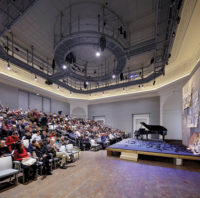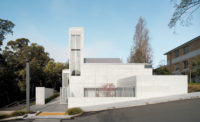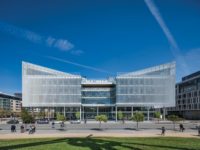Expectations are not usually high for the design of a nonprofit social service agency. When the client base and employees are overwhelmingly blind or vision impaired—as they are at the LightHouse, a 114-year-old private organization that provides rehabilitation, advocacy, and other services—those expectations slip even lower. But, thanks to the efforts of a forward-looking director and a board president who is an architect—both of whom are blind—and a committed design team led by Mark Cavagnero Associates, the new home of the San Francisco LightHouse, which needed to grow its space, stands such preconceptions on their heads.
Every element of the design—from circulation to lighting to mechanical equipment and the tactile and acoustic properties of surface materials—was shaped to the advantage of users whose visual challenges and compensating skills span an enormous range. The perceptions that LightHouse CEO Bryan Bashin most wanted to upend were those of new clients and their supporters. “Bryan wanted a space that was uplifting, not a woe-is-me experience,” said Mark Cavagnero, whose San Francisco–based firm was selected by a design committee as the architect for the $13 million project. Even so, the environment couldn’t be so “soft and gentle,” says Cavagnero, that clients would be unprepared for the hard corners of the real world. The LightHouse also had an extremely unusual resource in Chris Downey, a successful Bay Area architect who became blind during an operation to remove a brain tumor in 2008. Downey, who immediately decided to continue in his chosen career, joined the LightHouse board in 2009 and is now its president.
The new 45,000-square-foot facility—triple the size of the old space —occupies the top three floors of a Market Street office building that the organization acquired during the three-year design and development process, thanks to a surprise bequest after the relocation plan was already well along. Staff offices, a boardroom, and a small conference room occupy the ninth floor. The 10th floor holds the main teaching spaces and features a large multi-purpose room as well as a 12-station training kitchen, tech labs, a retail store, a low-vision optometry clinic, and music and videoconferencing rooms. Eleven dorm rooms (for short-term stays by students in immersive programs), a community kitchen and laundry, a maker’s workshop, fitness center, and a STEM classroom occupy the 11th floor.
A central stair connects the three levels and ties the entire space together. It was Cavagnero’s embrace of this element and the skylight that caps it that cinched the commission, says Downey. The other firms “failed to grasp the point of a skylight for blind users, but Cavagnero spoke convincingly and poetically about the power and meaning of natural light in our space.” A relatively small percentage of blind people have no sight at all, and even for those who can only distinguish light and shadow, daylight provides wayfinding cues and a sense of time passing. The stairway is wide enough to accommodate two people and one service dog. The element that was possibly the most fully tested in mock-up for the entire project is the handrail, made of Brazilian hardwood and molded to feel warm and welcoming in the hand and physically connect visitors to the space through touch and scale. The heart of the project, the stair, conveys the sounds of foot traffic and conversation and the smells wafting from the training kitchen, linking users to all manner of activity going on around them.
The design team worked with Arup, which conducted extensive digital acoustic modeling of materials and room environments to balance acoustic resonance and liveliness with functionality and comfort. The goal, says Downey, was to achieve a “desirable level of speech intelligibility.” Acoustics were modeled through digital animation to find a sound level that is warm but not overbearing, where cane taps and footfalls—human or canine—enliven the space. This drove the choice of a Brazilian hardwood for the staircase (in addition to the handrail) and polished concrete for the main circulation path. An aluminum band indicates the edge of this path and the start of carpeted function spaces, such as the tech labs. The team clad many of the public areas’ walls and ceilings in slatted hemlock, chosen for its acoustical and visual warmth. And they wrapped the walls in the training and volunteer rooms in brightly colored, acoustic felt panels that “beg to be touched,” says Katy Hawkins, project manager at Mark Cavagnero Associates.
In the boardroom, the modeling was used to allow for the admission of limited sound, like that of an occasional streetcar, keeping people connected to the city. But the general din of traffic is muted. Bashin’s embrace of the new LightHouse is anything but muted. “When people enter a blindness journey and come here,” he says, “instead of fear, they see hope, warmth, community, innovation. They see the LightHouse as an organization that is about empowering people to change.”







Post a comment to this article
Report Abusive Comment